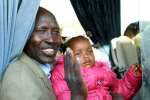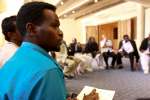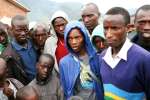UNHCR: The UN Refugee Agency
Also on this site
- Ruud Lubbers (Netherlands) 2001-2005
- Sudan country page
- Somalia country page
- East Asia and the Pacific regional page
- Ethiopia country page
- Rwanda country page
- Liberia country page
- Africa regional page
- Latin America regional page
- East and Horn of Africa regional page
- Refugee Figures
- Cameroon country page
- African Union Summit
- Middle East and North Africa regional page
- North Africa regional page
- Burundi country page
- Angola country page
- Uganda country page
- Zambia country page
- Central Africa and the Great Lakes regional page
- High Commissioner’s Global Initiative on Somali Refugees
- Tunisia country page
- South Sudan country page
- Southern Africa regional page
- Chad country page
- The IKEA Foundation
- West Africa regional page
 Global Consultations Solutions for Africa
Global Consultations Solutions for Africa
Further reading
- Informal Consultations on "New Approaches and Partnerships for Protection and Solutions for Africa"
- Informal Consultations on New Approaches and Partnerships for Protection and Solutions in Africa: Chairman's Summary
- Addressing Protracted Refugee Situations in Africa (Prepared for the Informal Consultations on New Approaches and Partnerships for Protection and Solutions in Africa, 14 December 2001)
- Discussion Paper on Protracted Refugee Situations in the African Region (Prepared for the Panel Discussion of 3 October 2002, During ExCom's 52nd Session)
 Global Consultations Discussion Papers on Solutions for Africa
Global Consultations Discussion Papers on Solutions for Africa
- Informal Consultations on "New Approaches and Partnerships for Protection and Solutions for Africa"
- Informal Consultations on New Approaches and Partnerships for Protection and Solutions in Africa: Chairman's Summary
- Addressing Protracted Refugee Situations in Africa (Prepared for the Informal Consultations on New Approaches and Partnerships for Protection and Solutions in Africa, 14 December 2001)
- Discussion Paper on Protracted Refugee Situations in the African Region (Prepared for the Panel Discussion of 3 October 2002, During ExCom's 52nd Session)
Resettlement from Tunisia's Choucha Camp
Between February and October 2011, more than 1 million people crossed into Tunisia to escape conflict in Libya. Most were migrant workers who made their way home or were repatriated, but the arrivals included refugees and asylum-seekers who could not return home or live freely in Tunisia.
UNHCR has been trying to find solutions for these people, most of whom ended up in the Choucha Transit Camp near Tunisia's border with Libya. Resettlement remains the most viable solution for those registered as refugees at Choucha before a cut-off date of December 1, 2011.
As of late April, 14 countries had accepted 2,349 refugees for resettlement, 1,331 of whom have since left Tunisia. The rest are expected to leave Choucha later this year. Most have gone to Australia, Norway and the United States. But there are a more than 2,600 refugees and almost 140 asylum-seekers still in the camp. UNHCR continues to advocate with resettlement countries to find solutions for them.
Resettlement from Tunisia's Choucha Camp
Photo Gallery: The Challenge of Forced Displacement in Africa
Africa is the continent most affected by the tragedy of forced displacement. While millions of refugees were able to return to Angola, Burundi, Liberia, Rwanda and South Sudan over the last 15 years, the numbers of internally displaced people continued to grow. At the beginning of 2009, in addition to some 2.3 million refugees, an estimated 11.6 million people were internally displaced by conflict in Africa.
To address forced displacement on the continent, the African Union is organizing a special summit on refugees, returnees and internally displaced people from October 19-23 in the Ugandan capital, Kampala. Heads of state and government will look at the challenges and at ways to find solutions to forced displacement. They are also expected to adopt a Convention for the protection and assistance of internally displaced people (IDP) in Africa, which would be the first legally binding instrument on internal displacement with a continental scope. This photo gallery looks at some of the forcibly displaced around Africa, many of whom are helped by UNHCR.
Photo Gallery: The Challenge of Forced Displacement in Africa
Congolese Refugees flee to Rwanda
In the first ten days of May 2012, more than 6,500 refugees from the Democratic Republic of the Congo crossed into Rwanda, fleeing fighting between the Congolese army and renegade soldiers. UNHCR and its UN partners worked with the Rwandan government to provide the refugees with humanitarian assistance in the early stages of the crisis, and to find solutions until it is safe for them to return.
Some of the refugees walked for days before reaching the Goma-Gisenyi border crossing between Democratic Republic of the Congo and Rwanda. They came with their belongings, including mattresses, clothing, perhaps a few toys for the children. The images are from the border and from the Nkamira Transit Centre, located 22 kilometres inside Rwanda. Accommodation at Nkamira is poor: the centre can only host up to 5,400 individuals. It is only temporary shelter, but numbers continue to swell as hundreds cross the border every day.




















































